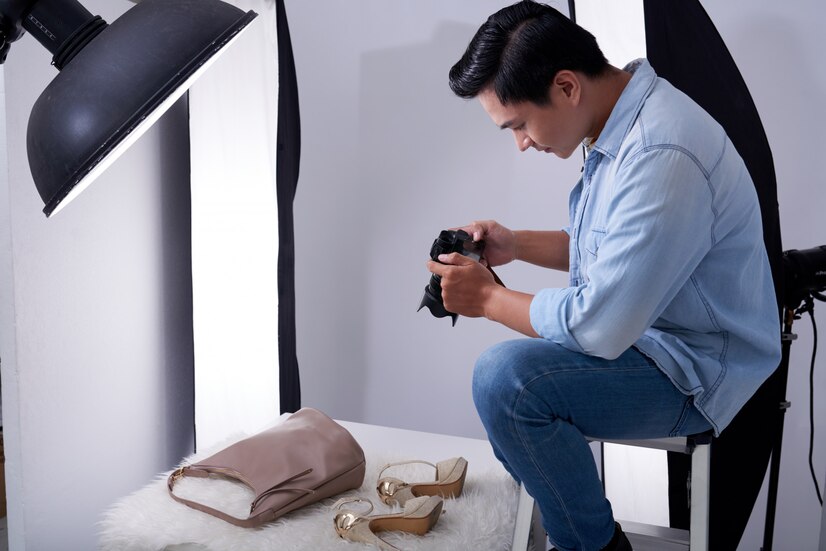Want to make your reflective products shine in photos? This step-by-step tutorial will teach you how to effectively capture their beauty.
How to Photograph Reflective Products
In this guide, we will explore the essential steps to successfully photograph reflective products.
1. Choose the Right Background:
Select a background that complements the reflective product. A neutral and non-reflective background, such as matte black or white, can help minimize distractions and focus attention on the product. Avoid using highly reflective or glossy backgrounds that can create additional reflections.
2. Control Lighting:
Proper lighting is crucial when photographing reflective products. Use diffused and soft lighting to reduce harsh reflections. Softboxes, umbrellas, or diffusion panels can help create a more even and controlled lighting environment. Consider using multiple light sources to illuminate the product from different angles, reducing the likelihood of unwanted reflections.
3. Use Polarizing Filters:
Polarizing filters are effective tools for minimizing reflections on reflective surfaces. Attach a circular polarizer to your camera lens and adjust its orientation to control and reduce glare. Experiment with the filter’s settings to find the optimal position that minimizes reflections while maintaining product visibility.
4. Set Up a Controlled Environment:
Minimize ambient light and control your shooting environment to reduce reflections. Shoot in a dedicated studio or use black curtains to block unwanted reflections. This controlled setting allows you to have better control over the lighting conditions, ensuring a more predictable and consistent result.
5. Position the Product Strategically:
Experiment with the placement of the reflective product to find the optimal angle that minimizes reflections and highlights its key features. Consider shooting from slightly above or below to control the reflections and emphasize specific details. Be patient and take the time to find the best positioning for each product.
6. Create a Reflection-Free Zone:
If possible, create a reflection-free zone around the product. Use flags or blackboards to block unwanted reflections or highlights. This can be particularly useful when dealing with reflective surfaces like glass or metal. The goal is to control the reflections and guide the viewer’s focus towards the product.
7. Use a Tripod:
Stability is crucial in product photography. Use a sturdy tripod to eliminate camera shake and ensure sharp images. A tripod also allows you to make precise adjustments to your composition and framing without introducing unwanted motion.
8. Post-Processing Techniques:
After capturing your images, consider using post-processing techniques to further enhance the final result. Adjusting contrast, saturation, and highlights in photo editing software can help fine-tune the appearance of the reflective product. Additionally, spot removal tools can be used to eliminate any remaining unwanted reflections.
9. Experiment and Learn:
Photographing reflective products may require some experimentation to achieve the desired results. Take test shots, review them, and make necessary adjustments to lighting, positioning, and settings. Learning from trial and error will enhance your skills and help you develop a better understanding of how to handle different reflective surfaces.
10. Professional Assistance:
If you find photographing reflective products challenging, consider seeking professional assistance. Experienced photographers or product photographers may have the expertise and equipment to efficiently handle reflective surfaces, ensuring high-quality images that effectively showcase the product.
Why Reflective Products Are Tricky to Shoot?
Reflective products pose unique challenges in photography due to their ability to mirror and reflect surrounding elements, which can lead to unwanted glare, highlights, and reflections. Several factors contribute to the trickiness of shooting reflective products:
1. Reflections:
Reflective surfaces, such as glass, metal, or polished materials, mirror their surroundings. This means that any light source, including studio lights, natural light, or even the photographer and camera, can be reflected in the product. Managing these reflections to avoid distracting elements requires careful positioning and control of lighting.
2. Glare and Highlights:
Reflective surfaces often produce intense glare and highlights when exposed to light. These bright spots can overshadow the product details, making it challenging to capture the subject’s true appearance. Controlling and minimizing glare is crucial to achieving a balanced and visually appealing image.
3. Inconsistency in Lighting:
Achieving uniform lighting on reflective products can be difficult. The reflective nature of the surface may cause uneven highlights and shadows, making it challenging to highlight specific details consistently. This requires precise control over lighting angles and intensity.
4. Light Source Placement:
The position of light sources becomes critical when shooting reflective products. Improperly placed lights can create unwanted reflections or hotspots on the surface. Achieving the right balance and avoiding direct light hitting the camera lens are essential considerations.
5. Background Reflections:
Reflective products can pick up reflections from the background or surroundings. This can lead to distracting elements appearing on the reflective surface, reducing the clarity and impact of the product in the photograph. Choosing an appropriate background and controlling reflections are essential to maintain focus on the product.
6. Polarization Issues:
Polarizing filters, while helpful in reducing reflections, can sometimes introduce unwanted artifacts or darken certain areas of the image. Finding the right balance with a polarizer requires experimentation and careful adjustments to avoid compromising the overall image quality.
7. Composition Challenges:
The reflective nature of the product can make it difficult to compose the shot effectively. Striking a balance between capturing the reflections to enhance the image and avoiding distracting elements requires careful consideration of the composition.
